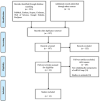Molecular Insight Into the Therapeutic Potential of Long Non-coding RNA-Associated Competing Endogenous RNA Axes in Alzheimer's Disease: A Systematic Scoping Review
- PMID: 34899268
- PMCID: PMC8656158
- DOI: 10.3389/fnagi.2021.742242
Molecular Insight Into the Therapeutic Potential of Long Non-coding RNA-Associated Competing Endogenous RNA Axes in Alzheimer's Disease: A Systematic Scoping Review
Abstract
Alzheimer's disease (AD) is a heterogeneous degenerative brain disorder with a rising prevalence worldwide. The two hallmarks that characterize the AD pathophysiology are amyloid plaques, generated via aggregated amyloid β, and neurofibrillary tangle, generated via accumulated phosphorylated tau. At the post-transcriptional and transcriptional levels, the regulatory functions of non-coding RNAs, in particular long non-coding RNAs (lncRNAs), have been ascertained in gene expressions. It is noteworthy that a number of lncRNAs feature a prevalent role in their potential of regulating gene expression through modulation of microRNAs via a process called the mechanism of competing endogenous RNA (ceRNA). Given the multifactorial nature of ceRNA interaction networks, they might be advantageous in complex disorders (e.g., AD) investigations at the therapeutic targets level. We carried out scoping review in this research to analyze validated loops of ceRNA in AD and focus on ceRNA axes associated with lncRNA. This scoping review was performed according to a six-stage methodology structure and PRISMA guideline. A systematic search of seven databases was conducted to find eligible articles prior to July 2021. Two reviewers independently performed publications screening and data extraction, and quantitative and qualitative analyses were conducted. Fourteen articles were identified that fulfill the inclusion criteria. Studies with different designs reported nine lncRNAs that were experimentally validated to act as ceRNA in AD in human-related studies, including BACE1-AS, SNHG1, RPPH1, NEAT1, LINC00094, SOX21-AS1, LINC00507, MAGI2-AS3, and LINC01311. The BACE1-AS/BACE1 was the most frequent ceRNA pair. Among miRNAs, miR-107 played a key role by regulating three different loops. Understanding the various aspects of this regulatory mechanism can help elucidate the unknown etiology of AD and provide new molecular targets for use in therapeutic and clinical applications.
Keywords: Alzheimer’s disease; antisense oligonucleotides; competing endogenous RNA; long non-coding RNA; miRNA sponge.
Copyright © 2021 Sabaie, Amirinejad, Asadi, Jalaiei, Daneshmandpour, Rezaei, Taheri and Rezazadeh.
Conflict of interest statement
The authors declare that the research was conducted in the absence of any commercial or financial relationships that could be construed as a potential conflict of interest.
Figures




Similar articles
-
CircRNA-Associated CeRNAs Regulatory Axes in Retinoblastoma: A Systematic Scoping Review.Front Oncol. 2022 Jul 5;12:910470. doi: 10.3389/fonc.2022.910470. eCollection 2022. Front Oncol. 2022. PMID: 35865469 Free PMC article.
-
The Traces of Dysregulated lncRNAs-Associated ceRNA Axes in Retinoblastoma: A Systematic Scope Review.Curr Eye Res. 2024 Jun;49(6):551-564. doi: 10.1080/02713683.2024.2306859. Epub 2024 Feb 1. Curr Eye Res. 2024. PMID: 38299506
-
The Perspective of Dysregulated LncRNAs in Alzheimer's Disease: A Systematic Scoping Review.Front Aging Neurosci. 2021 Sep 21;13:709568. doi: 10.3389/fnagi.2021.709568. eCollection 2021. Front Aging Neurosci. 2021. PMID: 34621163 Free PMC article.
-
Competing endogenous RNA (ceRNA) networks in Parkinson's disease: A systematic review.Front Cell Neurosci. 2023 Jan 24;17:1044634. doi: 10.3389/fncel.2023.1044634. eCollection 2023. Front Cell Neurosci. 2023. PMID: 36761351 Free PMC article.
-
Molecular mechanisms underlying actions of certain long noncoding RNAs in Alzheimer's disease.Metab Brain Dis. 2020 Jun;35(5):681-693. doi: 10.1007/s11011-020-00564-9. Epub 2020 Mar 17. Metab Brain Dis. 2020. PMID: 32185592 Review.
Cited by
-
Oxidative Stress in Intervertebral Disc Degeneration: New Insights from Bioinformatic Strategies.Oxid Med Cell Longev. 2022 Mar 31;2022:2239770. doi: 10.1155/2022/2239770. eCollection 2022. Oxid Med Cell Longev. 2022. PMID: 35401932 Free PMC article.
-
Exploring the Regulatory Landscape of Dementia: Insights from Non-Coding RNAs.Int J Mol Sci. 2024 Jun 4;25(11):6190. doi: 10.3390/ijms25116190. Int J Mol Sci. 2024. PMID: 38892378 Free PMC article. Review.
-
CircRNA-Associated CeRNAs Regulatory Axes in Retinoblastoma: A Systematic Scoping Review.Front Oncol. 2022 Jul 5;12:910470. doi: 10.3389/fonc.2022.910470. eCollection 2022. Front Oncol. 2022. PMID: 35865469 Free PMC article.
-
Identification and Analysis of BCAS4/hsa-miR-185-5p/SHISA7 Competing Endogenous RNA Axis in Late-Onset Alzheimer's Disease Using Bioinformatic and Experimental Approaches.Front Aging Neurosci. 2022 Feb 21;14:812169. doi: 10.3389/fnagi.2022.812169. eCollection 2022. Front Aging Neurosci. 2022. PMID: 35264942 Free PMC article.
-
Construction of lncRNA-ceRNA Networks to Reveal the Potential Role of Lfng/Notch1 Signaling Pathway in Alzheimer's Disease.Curr Alzheimer Res. 2022;19(11):772-784. doi: 10.2174/1567205020666221130090103. Curr Alzheimer Res. 2022. PMID: 36453506
References
-
- Arksey H., O’Malley L. (2005). Scoping studies: towards a methodological framework. Int. J. Soc. Res. Methodol. 8 19–32. 10.1080/1364557032000119616 - DOI
Publication types
LinkOut - more resources
Full Text Sources
Research Materials

